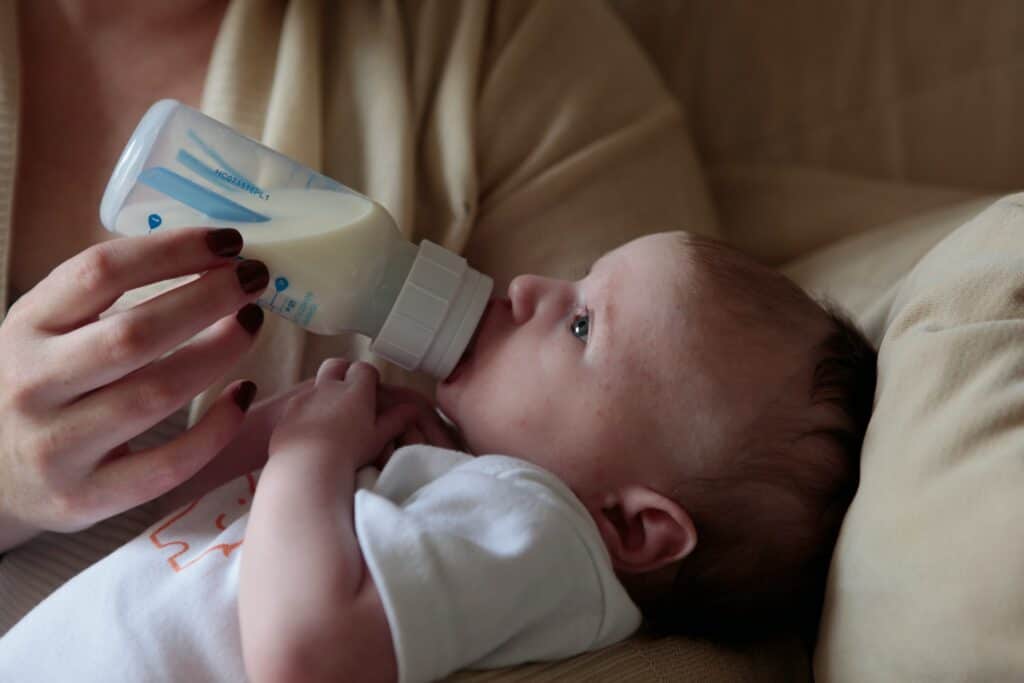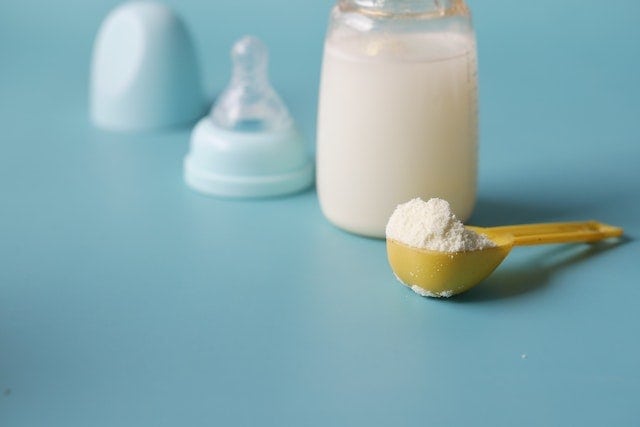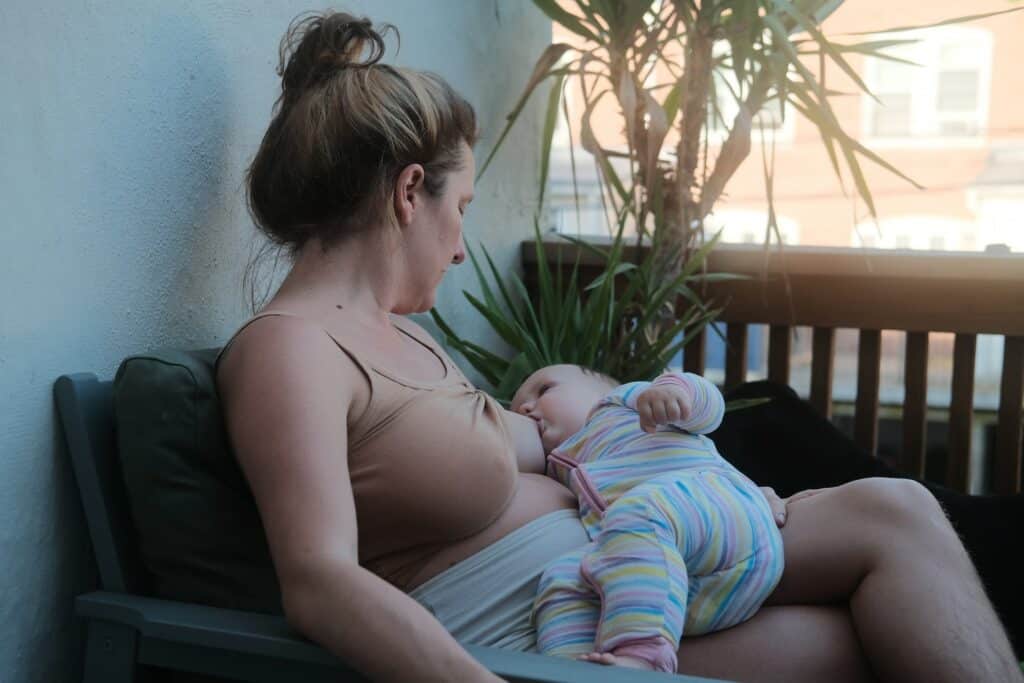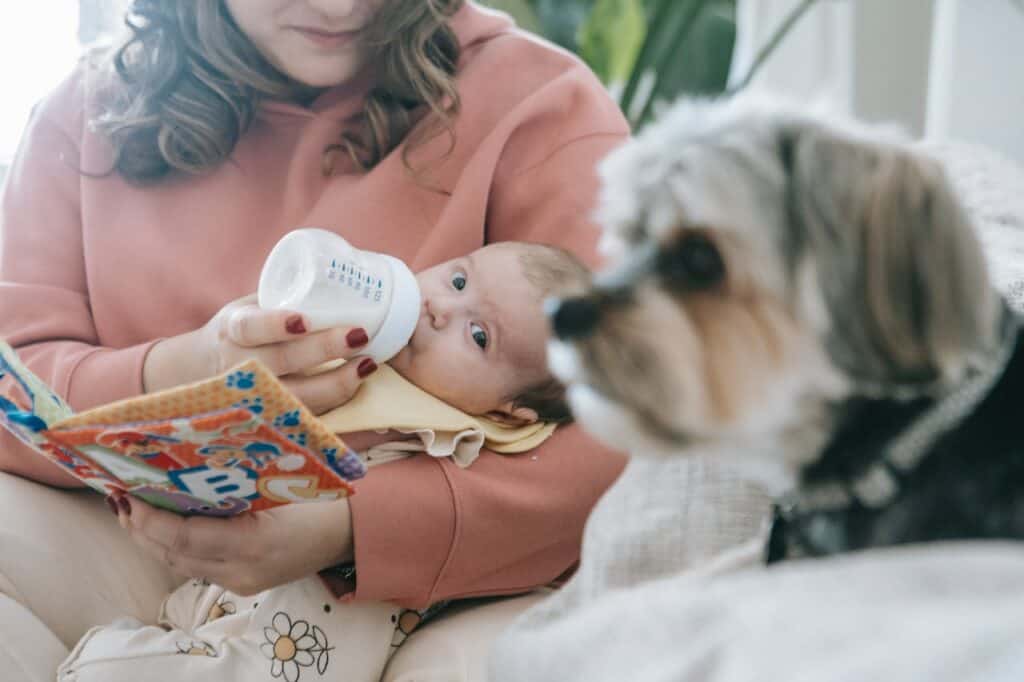Bottle feeding is an important part of parenting for many families. Whether you choose to bottle feed exclusively or supplement with formula, it’s essential to understand the basics of bottle feeding to ensure your baby receives proper nutrition and care.
Choosing the right bottle and nipple can make a significant difference in your baby’s feeding experience. There are many options available, including different materials, shapes, and flow rates. Understanding the differences between these options can help you choose the best bottle and nipple for your baby’s needs.
Key Takeaways
- Choosing the right bottle and nipple is essential for successful bottle feeding.
- Proper preparation of formula and feeding techniques are crucial for your baby’s health.
- Knowing how to handle potential challenges and transition from breastfeeding to bottle feeding can make the process smoother.
Understanding Bottle Feeding
Bottle feeding is a popular method of feeding infants. It involves using a bottle filled with formula or breast milk to feed the baby. Here are some tips for understanding bottle feeding:
- Choosing the right bottle: There are many different types of bottles available on the market. It is important to choose a bottle that is easy for the baby to hold and drink from. Some bottles have wide necks, while others have narrow necks. Some have anti-colic features to reduce the amount of air the baby swallows. It is important to experiment with different bottles to find the one that works best for the baby.
- Preparing the formula: If using formula, it is important to follow the instructions on the package carefully. The ratio of water to powder must be correct to ensure that the baby is getting the right amount of nutrients. It is also important to sterilize the bottles and nipples before use to prevent the baby from getting sick.
- Feeding the baby: When feeding the baby, it is important to hold the bottle at a slight angle to prevent air from entering the nipple. The baby should be held in a semi-upright position to prevent choking. It is also important to burp the baby after feeding to release any trapped air.
- Frequency of feedings: The frequency of feedings will depend on the age of the baby. Newborns typically need to be fed every 2-3 hours, while older babies can go longer between feedings. It is important to pay attention to the baby’s hunger cues and feed them when they are hungry.
Overall, bottle feeding can be a great option for parents who are unable to breastfeed or choose not to. With the right preparation and technique, bottle feeding can provide the baby with the nutrients they need to grow and thrive.
Choosing the Right Bottle and Nipple
When it comes to bottlefeeding, choosing the right bottle and nipple can make a big difference in your baby’s feeding experience. Here are some things to consider when selecting a bottle and nipple.

Bottle Types
There are several types of bottles available in the market. Some popular ones include:
- Standard Bottles: These are the most common type of bottles and are available in different sizes and shapes. They can be made of plastic, glass, or silicone.
- Wide-Neck Bottles: These bottles have a wider opening than standard bottles, making them easier to clean and fill. They are ideal for babies who have trouble latching onto the nipple.
- Angled Bottles: These bottles are designed to reduce air intake, which can help reduce colic and gas. They are also easier to hold and feed at an angle.
- Disposable Bottles: These are convenient for on-the-go feeding and can be disposed of after use.
Nipple Shapes
The shape of the nipple can also affect your baby’s feeding experience. Here are some common nipple shapes:
- Standard Nipple: This nipple has a round shape and is suitable for most babies.
- Orthodontic Nipple: This nipple has a flattened shape and is designed to mimic the shape of a mother’s nipple.
- Wide Nipple: This nipple has a wider base and is suitable for babies who have trouble latching onto the nipple.
- Anti-Colic Nipple: This nipple has a venting system that helps reduce air intake, which can help reduce colic and gas.
It’s also important to consider the nipple hole size. A slow flow nipple is suitable for newborns, while a faster flow nipple is suitable for older babies.
When selecting a bottle and nipple, it’s important to consider your baby’s needs and preferences. Some babies may prefer a certain bottle or nipple shape, while others may not. It may take some trial and error to find the right combination that works for your baby.
Using a bottle warmer can also help make feeding time more convenient and comfortable for your baby. Just make sure to follow the manufacturer’s instructions for safe use.
Overall, choosing the right bottle and nipple can help make feeding time a more enjoyable experience for both you and your baby.
Preparation of Formula
Preparing formula for bottle feeding requires careful attention to detail and following the correct procedures to ensure the safety and well-being of the baby. Here are some tips for preparing formula:

Water and Formula Ratio
The water and formula ratio is crucial for the baby’s nutrition and health. Always follow the instructions on the formula packaging for the correct ratio. Typically, one scoop of powdered formula is mixed with two ounces of water, but this can vary depending on the brand and type of formula.
When measuring the water, use clean, sterile water. If using tap water, boil it for at least one minute and let it cool before mixing with the formula. Alternatively, use bottled water that is labeled as safe for infants.
Sterilizing Equipment
It is important to sterilize all equipment used for preparing and feeding formula to prevent the growth of harmful bacteria. This includes bottles, nipples, and any utensils used for mixing and measuring.
There are several methods for sterilizing equipment, including boiling, using a microwave sterilizer, or using a sterilizing solution. Follow the instructions on the sterilizing product for the correct procedure.
When using a microwave to sterilize, ensure that all equipment is microwave-safe and follow the manufacturer’s instructions. Alternatively, use a thermos to sterilize by filling it with boiling water and submerging the equipment for at least five minutes.
By following these tips for preparing formula, parents can ensure that their baby is getting the nutrition they need in a safe and hygienic manner.
Feeding the Baby
When it comes to bottle feeding, there are a few things to keep in mind to ensure that the baby is getting the nutrition they need while also being comfortable and happy. Here are some tips to help with feeding the baby:

Recognizing Hunger Cues
It’s important to recognize hunger cues so that the baby can be fed as soon as they are hungry. Some common hunger cues include rooting, sucking on fingers or hands, smacking lips, and fussiness. It’s important to not wait too long to feed the baby once they start showing these signs of hunger.
Feeding Positions
There are a few different feeding positions that can be used depending on what works best for the baby and the caregiver. Some common positions include cradling the baby in the arms, holding the baby in a sitting position, or using a nursing pillow to support the baby. It’s important to make sure that the baby’s head is elevated during feeding to prevent choking and gas.
Pacing the Feed
Paced bottle feeding is a technique that can help prevent overfeeding and reduce the risk of gas and reflux. This involves holding the bottle horizontally and allowing the baby to suck at their own pace, taking breaks to burp the baby and allowing them to rest. It’s also important to make eye contact with the baby during feeding to help them feel connected and comforted.
By keeping these tips in mind, caregivers can ensure that the baby is getting the nutrition they need while also being comfortable and happy during feeding.
Post-Feeding Care
After feeding your baby, it is important to take care of them to ensure their comfort and safety. Here are some tips for post-feeding care:
Burping the Baby
Burping is an essential part of bottle-feeding. It helps to release the air that your baby may have swallowed while feeding, which can cause discomfort and even pain. Here are some tips for burping your baby:
- Hold your baby upright against your chest or on your lap.
- Gently pat or rub their back until they burp.
- If your baby doesn’t burp after a few minutes, try again later.
Cleaning the Equipment
Cleaning your baby’s feeding equipment is important to prevent the growth of harmful bacteria. Here are some tips for cleaning the equipment:
- Wash the bottle, nipple, and cap with warm, soapy water after each use.
- Use a bottle brush to clean hard-to-reach areas.
- Rinse the equipment thoroughly with hot water.
- Sterilize the equipment by boiling it in water for at least five minutes, or by using a sterilizer.
It is important to note that bottle caries can occur if you do not take care of your baby’s teeth properly. You should avoid letting your baby fall asleep with a bottle in their mouth, and wipe their gums with a clean, damp cloth after each feeding.
Overall, proper post-feeding care is essential to ensure your baby’s comfort and safety. By following these tips, you can help keep your baby healthy and happy.
Potential Challenges and Solutions

Nipple Confusion
One potential challenge that bottle-fed infants may experience is nipple confusion. This occurs when a baby has difficulty switching between the bottle and the breast, which can lead to frustration for both the baby and the caregiver. To prevent nipple confusion, caregivers should wait until breastfeeding is well-established before introducing a bottle.
If nipple confusion does occur, there are a few solutions that caregivers can try. First, they can experiment with different types of bottles and nipples to find one that the baby prefers. Additionally, caregivers can try feeding the baby with a cup or spoon instead of a bottle, or they can try using a nipple shield to help the baby transition between the breast and the bottle.
Overfeeding
Another potential challenge with bottle-feeding is overfeeding. Because it can be difficult to gauge how much milk a baby has consumed, some caregivers may inadvertently overfeed their baby, which can lead to discomfort, vomiting, and other issues.
To prevent overfeeding, caregivers should pay attention to the baby’s hunger cues and stop feeding when the baby seems full. Additionally, they can try using a slower-flow nipple to help the baby regulate their intake.
Gas and Discomfort
Finally, some bottle-fed infants may experience gas and discomfort, which can be caused by a variety of factors, including swallowing air during feeding or intolerance to certain types of formula.
To alleviate gas and discomfort, caregivers can try burping the baby frequently during feeding and keeping the baby upright for at least 30 minutes after feeding. Additionally, they can experiment with different types of formula to see if the baby tolerates them better. In some cases, a pediatrician may recommend a specialized formula for babies with digestive issues.
Transitioning from Breastfeeding to Bottle Feeding
Breastfeeding is a personal choice, and many mothers choose to switch to bottle feeding for various reasons. Whether it’s because of work, convenience, or personal preference, transitioning from breastfeeding to bottle feeding can be a challenging task. Here are some tips to make the transition go smoothly.

Introducing the Bottle
When introducing the bottle, it’s important to choose the right bottle and nipple. There are many different types of bottles and nipples available, so it’s essential to find one that your baby likes. Some babies prefer a certain shape or flow, so it may take some trial and error to find the right one. It’s also a good idea to have someone else give the bottle to your baby, as they may not take it from you if they associate you with breastfeeding.
It’s also important to introduce the bottle gradually. Start by offering one bottle a day and gradually increase the number of bottles as your baby gets used to it. You can also try offering the bottle when your baby is relaxed and not too hungry, as they may be more willing to try something new.
Maintaining Milk Supply
When transitioning from breastfeeding to bottle feeding, it’s important to maintain your milk supply. The best way to do this is to continue to pump regularly, even if you’re not breastfeeding. This will help your body continue to produce milk and prevent engorgement.
It’s also important to make sure you’re getting enough rest and staying hydrated. Breastfeeding can be exhausting, and it’s essential to take care of yourself to ensure that you can continue to produce milk.
If you’re struggling to maintain your milk supply, there are several things you can try. You can try pumping more frequently, using a breast pump that has a stronger suction, or taking supplements that can help increase milk production.
In conclusion, transitioning from breastfeeding to bottle feeding can be a challenging task, but with the right preparation and patience, it can be a smooth process. By introducing the bottle gradually and maintaining your milk supply, you can ensure that your baby is getting the nutrition they need while also giving yourself the flexibility and convenience that comes with bottle feeding.
Health Considerations in Bottle Feeding
When it comes to bottle feeding, there are a few health considerations that parents should keep in mind to ensure their baby’s well-being. The two most important factors are weight monitoring and infection risks.

Weight Monitoring
One of the benefits of bottle feeding is that parents can easily monitor their baby’s weight gain. It is important to ensure that the baby is gaining weight at a healthy rate. A pediatrician or doctor can advise on how much weight gain is appropriate for the baby’s age and size.
Parents should also keep an eye on the number of calories and protein their baby is getting from the formula. It is important not to overfeed the baby, as this can lead to obesity later in life. On the other hand, underfeeding can lead to slow weight gain and developmental delays.
Infection Risks
Bottle feeding poses some risks for infections, particularly ear infections and bacterial infections. Parents should always prepare the formula according to the instructions on the package, and use clean bottles and nipples. It is also important to clean and sterilize the bottles and nipples regularly to prevent the buildup of bacteria.
Parents should be aware of the signs of infection, such as fever, fussiness, and diarrhea. If they suspect their baby has an infection, they should seek medical attention immediately.
In summary, parents should monitor their baby’s weight gain and be mindful of the risks of infection when bottle feeding. By following the appropriate guidelines and seeking medical attention when necessary, parents can ensure their baby’s health and well-being.
Night Time Bottle Feeding
Night time feedings can be challenging for both parents and babies. Here are some tips to make night time bottle feeding a little easier.
Maintaining Sleep Schedule
It’s important to try to maintain a consistent sleep schedule for your baby, even during night time feedings. This can help them establish a routine and improve their overall sleep quality. To do this, try to keep the room dark and quiet during feedings, and avoid talking or playing with your baby too much.
Warming the Bottle
Warming the bottle can help your baby feel more comfortable and make the feeding process smoother. There are a few different ways to warm a bottle, including using a bottle warmer or placing the bottle in a bowl of warm water. It’s important to test the temperature of the milk before feeding your baby to make sure it’s not too hot.
Using a bottle warmer can be a convenient option, as it can warm the bottle quickly and evenly. Some bottle warmers even come with an automatic shut-off feature to help prevent overheating.
Conclusion
Night time feedings can be challenging, but with a few simple tips, you can make the process a little easier for both you and your baby. By maintaining a consistent sleep schedule and warming the bottle properly, you can help your baby get the nutrition they need while also promoting healthy sleep habits.
Bottle Feeding Guidelines for Caregivers
When it comes to bottle feeding, caregivers need to be well-informed and follow specific guidelines to ensure the baby’s safety and health. Here are some guidelines to keep in mind:

Feeding Schedule
Newborns typically need to be fed every 2-3 hours, which means caregivers need to be prepared to feed the baby frequently. It’s important to pay attention to the baby’s hunger cues, such as rooting or sucking on their hands, to determine when they need to be fed. Overfeeding can be just as harmful as underfeeding, so caregivers should avoid forcing the baby to finish a bottle if they’re not hungry.
Preparing the Bottle
Caregivers should always wash their hands before preparing a bottle. The bottle, nipple, and any other equipment should also be thoroughly cleaned and sterilized before use. Caregivers should follow the instructions on the formula container to prepare the bottle correctly, using the appropriate amount of water and formula. It’s important to mix the formula well to ensure there are no clumps or air bubbles.
Feeding the Baby
When feeding the baby, caregivers should hold them in a semi-upright position, with their head slightly elevated. The nipple should be placed in the baby’s mouth, and the caregiver should make sure the baby is latching onto the nipple properly. It’s important to keep an eye on the baby while they’re feeding, as they can choke or have difficulty breathing if they’re not positioned correctly.
Burping the Baby
After the baby has finished feeding, caregivers should burp them to help release any trapped air. This can be done by holding the baby upright and gently patting or rubbing their back. It’s important to burp the baby regularly during feeding to prevent discomfort and reduce the risk of spitting up.
Following these guidelines can help ensure that bottle feeding is a safe and healthy experience for both the caregiver and the baby.
Bottle Feeding and Dental Health
Bottle feeding is a common practice among parents to feed their infants. However, it is essential to be aware of the potential dental health risks associated with bottle feeding. Tooth decay, also known as bottle caries, is a common dental health issue that can be caused by prolonged bottle feeding.
Pediatricians and doctors recommend that parents should avoid allowing their infants to fall asleep with a bottle in their mouth. The milk or formula can pool in the baby’s mouth, increasing the risk of tooth decay. Instead, parents should hold the infant while feeding and remove the bottle once the feeding is complete.
It is also crucial to clean the baby’s mouth after feeding. Parents should gently wipe the gums and teeth with a clean, damp cloth to remove any milk residue. As the baby grows, parents should introduce a cup and start weaning the baby off the bottle.
In addition to these preventative measures, parents should also take their infants for regular dental checkups. The dentist can detect any early signs of tooth decay and provide appropriate treatment.
Overall, parents should be mindful of the potential dental health risks associated with bottle feeding. By following these tips, parents can help prevent tooth decay and promote good dental health for their infants.
Tips for Bottle Feeding
When it comes to bottle feeding, there are a few things to keep in mind to ensure that your baby is comfortable and well-fed. Here are some tips to help you out:

Guidelines
First and foremost, it’s important to follow the guidelines on the formula or breast milk container. These guidelines will tell you how much to feed your baby based on their age and weight. It’s important to stick to these guidelines to ensure that your baby is getting the proper nutrition.
Comfort
Make sure your baby is comfortable while feeding. This means that they should be in a quiet, calm environment and that their diaper is clean and dry. If your baby is fussy, try burping them or changing their position to see if that helps.
Skin Contact
Skin-to-skin contact is important during feeding time. This helps your baby feel secure and can also help with bonding. If possible, try to hold your baby close to your chest while feeding.
Upright Position
Feeding your baby in an upright position can help prevent them from swallowing air, which can lead to gas and discomfort. Hold your baby in a slightly upright position and tilt the bottle so that the nipple is always full of milk.
Remember, every baby is different and what works for one may not work for another. If you have any concerns or questions about bottle feeding, don’t hesitate to talk to your pediatrician.
Frequently Asked Questions
What are the best baby bottles for newborns?
When it comes to choosing the best baby bottles for newborns, the most important factor to consider is the nipple. Look for bottles with a slow flow nipple that mimics the flow of breast milk. Some popular options include Dr. Brown’s Natural Flow bottles, Tommee Tippee Closer to Nature bottles, and Philips Avent Natural bottles.
How long should each bottle feed take?
What are the best baby bottles for newborns?
When it comes to choosing the best baby bottles for newborns, the most important factor to consider is the nipple. Look for bottles with a slow flow nipple that mimics the flow of breast milk. Some popular options include Dr. Brown’s Natural Flow bottles, Tommee Tippee Closer to Nature bottles, and Philips Avent Natural bottles.
What is the easiest position to bottle feed a newborn?
The most common and easiest position to bottle feed a newborn is to hold them in a semi-upright position, with their head slightly elevated. Cradle the baby’s head with one hand and hold the bottle with the other. Make sure the nipple is always filled with milk to prevent your baby from swallowing air.
How can I get my baby to bottle feed better?
To help your baby bottle feed better, try different nipple shapes and sizes until you find one that works best for them. You can also try gently rubbing your baby’s cheek or chin to encourage them to open their mouth. Additionally, make sure the nipple is filled with milk and that your baby is in a comfortable position.
What are some bottle feeding positions for breastfed babies?
If you’re transitioning from breastfeeding to bottle feeding, you may want to try positions that mimic breastfeeding. Some options include holding the baby in a cradle position or a cross-cradle position, or using a nursing pillow to support the baby.
What are some common mistakes to avoid when bottle feeding a baby?
One common mistake is overfeeding your baby. Pay attention to their hunger cues and stop feeding when they show signs of being full. Another mistake is not burping your baby frequently enough, which can lead to discomfort and gas. Make sure to burp your baby after every feeding session. Finally, avoid propping the bottle up and leaving your baby unattended during feeding. This can increase the risk of choking and other complications.

Iesha is a loving mother of 2 beautiful children. She’s an active parent who enjoys indoor and outdoor adventures with her family. Her mission is to share practical and realistic parenting advice to help the parenting community becoming stronger.
